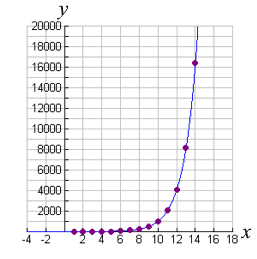A massive catastrophe is speedily reaching us. Its not a doomsday forecast, predicted in the year 1801 by a psychic named Rasus. Nor is it propaganda from giant corporation funded newspapers to insight hysteria into the consumer to buy buy buy! What we are faced with is the pure facts of exponential growth rates.
For years we have been headlined with such slogans as “Our oil reserves have been increasing production at 4% per year, which means that we have more oil than every before in the reserves”, or “the world population must increase at a rate of 3% per year or we will not have enough people to fill our factories.” How do we continue to support these same newspapers and TV programs when the fill us with this junk? It boggles my mind.
What we do not understand is how this continued 3% or 5% growth rates effect us in the long run. What this ‘positive’ growth rate fails to inform us about, is how this actually works.
First of all, when you have a 5% growth, it compounds on top of the year before, so we now have a 5% on the 105%. So, lets use numbers.
Year 1, we have 100.
- 2 = 105
- 3 = 110.25
- 4=115.76
- 5=121.55
- 6=127.62
- 7=134.01
- 8=140.71
- 9=147.74
- 10=155.13
- 11=162.89
- 12=171.03
- 13=179.59
- 14=188.56
- 15=197.99
- 16=207.89
So you see, at a growth rate of 5% we will have doubled in ~15years. One might be inclined to think 100/5 = 20, so it should take 20 years to double… But no.
This simple math can be estimated with the function ln(2)/% = 70/rate. So, for our case, 70/5=14. Pretty simple. The magic thing to remember is the 70. Somebody quotes you: “oh yeh, the expected growth of this stock is 7% per year,” or “These equity funds grow at a rate of .002% per year.” Now you’ll be able to say “One second, let me take out my smart phone calculator and add these up.. 70/7 = 10 years to double! Wow great investment! 70/.002=35000 years to double??! I think I’ll stick it under the mattress, thanks all the same.”
The other amazing thing, is that when we reach this double amount, it means that the total amount we are now seeing is more than double the previous double point. So, to show figures, year 1’s 100, the amount the year 16 (doubling year) has increased by is 107.89. This means that it has more than doubled. And this continues on forever, as long as the exponential growth (or compounded continual growth continues).
To see this in a graph:
 This simple graph has year in the x axis, and resultant growth total in the y-axis. You can see that between year 12 and 13, it is very obvious that the value has gone from 4000, to above 8000; more than doubled. It doesn’t just occur in those years though, it occurs in all the years prior as well, so every doubling period sees the same growth. Every time that 70/% year hits, this doubling factor is felt.
This simple graph has year in the x axis, and resultant growth total in the y-axis. You can see that between year 12 and 13, it is very obvious that the value has gone from 4000, to above 8000; more than doubled. It doesn’t just occur in those years though, it occurs in all the years prior as well, so every doubling period sees the same growth. Every time that 70/% year hits, this doubling factor is felt.
Another thing that I would like to point out is that if you notice at any two points, if you take the same two previously mentioned at year 12 and 13, you see that the 4000 it has grown by in year 13 (to 8000 from 4000), is a growth of more than what the entire total of all the years before have accumulated to, which was 4000. This is in itself the definition of a doubling time, which is the time it takes when you do the 70/% growth factor, so you can see how quickly this will grow at?
I hope this has enlightened you a little bit, or made you more aware of what it actually means to be a compounding or exponential growth, and I hope it will make you more aware of the situation that is inferred when somebody on the news says: “We need our population to grow at 3% per year, that would be a good sustainable thing”, or “Our oil consumption has a steady growth of 3.5% per year, which is expected to grow over the next 20 years by 0.3% per year, which should give our company a great stance in the markets.”
I want to leave you with this 8 part series of videos to watch off of youtube, or anywhere else you can find, so that you can learn this from an expert Dr. Albert A Bartlett who is famous for his lectures on exponents and who will explain it in far better terms than I can!
[youtube=http://www.youtube.com/watch?v=F-QA2rkpBSY]
Good luck!




